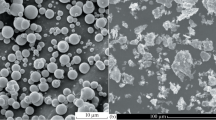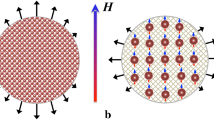Abstract
Magnetorheological elastomers generally consist of a natural or synthetic rubber matrix interspersed with micron-sized ferromagnetic particles. The magneto-elastic properties of such a composite are not merely a sum of the elasticity of the polymer and the stiffness and magnetic properties of the filler, but also the result of a complex synergy of several effects, relevant at different length scales and detectable by different techniques. In our present work we investigate the microstructures, the surface magnetic properties, and the elastic properties of new isotropic and anisotropic magnetorheological elastomers prepared using silicone rubber and soft magnetic carbonyl iron microspheres. Similar samples were previously investigated by means of small-angle neutron scattering, which proved to be a useful method in the investigation of their microscopic properties. We combined the data from the atomic force microscopy measurements with those from small-angle neutron scattering to better understand the complicated behaviour of the studied materials. The measurements were performed by atomic force microscopy in the following modes: standard imaging non-contact atomic force microscopy, magnetic force microscopy, and nanoindentation. A comparative study of samples with different particle concentrations and strength of magnetic field applied during the polymerization process is developed.









Similar content being viewed by others
References
Jolly, M.R., Carlson, J.D., Munoz, B.C.: A model of the behaviour of magnetorheological materials. Smart Mater. Struct. 5, 607–614 (1996)
Ginder, J.M., Nichols, M.E., Elie, L.D., Tardiff, J.L.: Magnetorheological elastomers: properties and applications. Proc. SPIE 3675, 131–138 (1999)
Carlson, J.D., Jolly, M.R.: MR fluid, foam and elastomer devices. Mechatronics 10, 555–569 (2000)
Bica, I.: Advances in magnetorheological suspension: production and properties. J. Ind. Eng. Chem. 12(4), 501–515 (2006)
Bica, I.: Giant resistances based on magnetorheological suspensions. J. Ind. Eng. Chem. 13(2), 299–304 (2007)
Bica, I.: Influence of the transverse magnetic field intensity upon the electric resistance of the magnetorheological elastomer containing graphite microparticles. Mater. Lett. 63(26), 2230–2232 (2009)
Fan, Y., Gong, X., Xuan, S., Zhang, W., Zheng, J., Jiang, W.: Interfacial friction damping properties in magnetorheological elastomers. Smart Mater. Struct. 20 (2011). doi:10.1088/0964-1726/20/3/035007
Ruddy, C., Ahearne, E., Byrne, G.: A review of magnetorheological elastomers: properties and applications. Advanced Manufacturing Science (AMS) Research. http://www.ucd.ie/mecheng/ams/news_items/Cillian%20Ruddy.pdf.Accessed 20 (2012)
Bica, I., Liu, Y.D., Choi, H.J.: Magnetic field intensity effect on plane electric capacitor characteristics and viscoelasticity of magnetorheological elastomer. Colloid Polym. Sci. (2012). doi:10.1007/s00396-012-2627-9
Balasoiu, M., Craus, M.L., Anitas, E.M., Bica, I., Plestil, J., Kuklin, A.I.: Microstructure of stomaflex based magnetic elastomers. Phys. Solid State 52(5), 917–921 (2010)
Bica, I.: Magnetoresistor sensor with magnetorheological elastomers. J. Ind. Eng. Chem. 17, 83–89 (2011)
Bica, I.: The influence of hydrostatic pressure and transverse magnetic field on the electric conductivity of the magnetorheological elastomers. J. Ind. Eng. Chem. 18, 483–486 (2012)
Fuchs, A., Zhang, Q., Elkins, J., Gordaninejad, F., Evrensel, C.: Development and characterization of magnetorheological elastomers. J. Appl. Polym. Sci. 105, 2497–2508 (2007)
Fan, Y., Gong, X., Xuan, S., Zhang, W., Zheng, J., Jiang, W.: Interfacial friction damping properties in magnetorheological elastomers. Smart Mater. Struct. 20, 035007 (2011). doi:10.1088/0964-1726/20/3/035007
Moeller, G., Domnich, V.: AFM nanoindentation of polymers. Microsc. Microanal. 13(2), 186–187 (2007). doi:10.1017/S1431927607073850
Hengsberger, S., Kulik, A., Zysset, Ph.: A combined atomic force microscopy and nanoindentation technique to investigate the elastic properties of bone structural units. Eur. Cells Mater. 1, 12–17 (2001)
Pauschitz, A., Schalko, J., Koch, T., Eisenmenger-Sittner, C., Kvasnica, S., Roy, M.: Nanoindentation and AFM studies of PECVD DLC and reactively sputtered Ti containing carbon films. Bull. Mater. Sci. 26(6), 585–591 (2003)
Kim, Y., Yang, Y.I., Choi, I., Yi, J.: Dependence of approaching velocity on the force-distance curve in AFM analysis. Korean J. Chem. Eng. 27(1), 324–327 (2010)
Acknowledgements
This study was supported by the Joint Institute for Nuclear Research (JINR)—Romania Cooperation, scientific projects No. 146,151/15.03.2011 item 26 and No. 82/06.02.2012 item 33, and JINR Scientific Topic No. 04-4-1069-2009/2014.
Author information
Authors and Affiliations
Corresponding author
Rights and permissions
About this article
Cite this article
Iacobescu, G.E., Balasoiu, M. & Bica, I. Investigation of Surface Properties of Magnetorheological Elastomers by Atomic Force Microscopy. J Supercond Nov Magn 26, 785–792 (2013). https://doi.org/10.1007/s10948-012-1903-8
Received:
Accepted:
Published:
Issue Date:
DOI: https://doi.org/10.1007/s10948-012-1903-8




